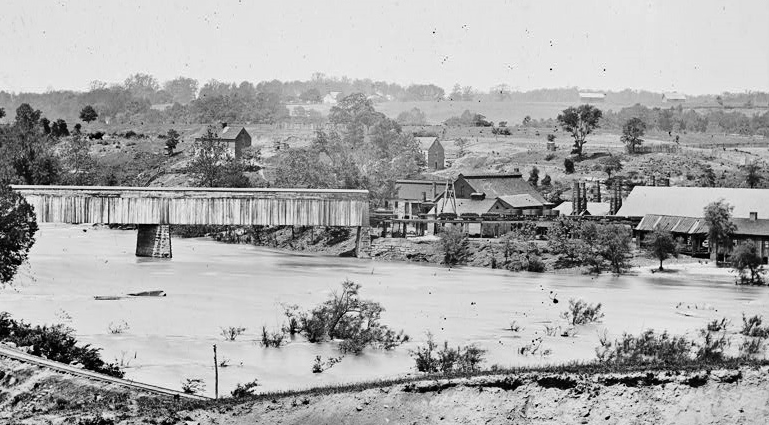As native Richmonders, we know Belle Isle like the back of our hand.
We spend our days running trails, biking along paths, spending lazy days sunning on the rocks, or trying to handle the always uncertain James River. If you’re not from around here, you might not be aware of all the magic that Belle Isle has to offer and how ingrained it is in our city. So we want to share what makes Belle Isle so amazing that we chose it as the moniker for our business.
Belle Isle is a small island in the middle of the James River in Richmond, Virginia. The island is filled with bicycle trails and hiking trails and is a popular recreational site. What many don’t know, however, is that Belle Isle has had a rich and interesting history. Over the years, the island has performed a number of different roles. It was once used as a prisoner of war camp, for example, and also featured a nail factory, school, church, and general store.
Early Belle Isle history: 1600s to 1700s
Belle Isle was first explored by Captain John Smith in 1607. John Smith called it “Broad Rock” island, likely due to its large number of broad rocks. But due to Native American populations being hostile towards settlement in the region, the actual founding of Richmond was delayed until 1742. Richmond was seen as a valuable city due to its strategic location on the James River. It was close to Jamestown and was established around James Falls - the highest navigable point on the James River. One of the earliest mentions of Belle Isle is by William Byrd, who describes the island as “an agreeable hermitage for any good Christian who had a mind to retire from the world.” (A description that many Richmonders agree with today - it’s definitely an escape from every day life and a central piece of the city!)
Belle Isle during the early 1800s
During the 1800’s Belle Isle was home to several different industries., which makes sense as it was originally a lottery prize owned by notable historical figures like Bushrod Washington (nephew of George Washington) and Henry Lee (father of Robert E. Lee).
Soon after Richmond was founded in 1742, a fishery was built on Belle Isle. Then it was transformed in 1814, when a company called the Old Dominion Iron and Nail Company established a nail factory and ironworks on the island. Just prior to the Civil War, there was a school, church, and general store in the island, establishing Belle Isle as a small, but bustling community.
During the early 1800s, one other manufacturer established itself on the island: Belle Isle Manufacturing, which specialized in manufacturing copper kettles. These copper kettles were used to create the world’s first premium moonshine. Apparently moonshine was as popular in the 1800’s as it is now, and demand was large enough that in 1836, Belle Isle Manufacturing acquired the island’s ironworks and enlarged it to suit their needs.
Belle Isle during the Civil War
During the Civil War, Belle Isle took on a totally new role. The Old Dominion Iron and Nail Works became a major manufacturer and acquired the Belle Isle Manufacturing Company in 1851. During the war, Old Dominion created high-quality horse and mule shoes along with camp equipment – including copper kettles.
The South’s secret weapon, the CSS Virginia, also known as the Merrimac, owes its unique armor to Belle Isle. Old Dominion’s mills manufactured armor plating for the ironclad warship along with other ships used during the Civil War.
In that sense, Belle Isle was an important production center during the Civil War. It became even more productive when parts of Belle Isle were converted into prisoner of war camps when prisoners of war and slaves supplemented the labor force at Belle Isle. Over the course of the war, approximately 20,000 prisoners would pass through the camp. At some points, the small isle was home to as many as 6,000 POWs.
Converting to peacetime use
After the Civil War, Belle Isle continued to be used as a factory. Its ironworks were once again used to manufacture nails instead of camp supplies and warship plating and the Old Dominion Nail Factory and Manufactory would remain open until it’s close in 1972. In addition to being a manufacturing hub, in 1904, the Virginia Electric Power Company established a hydroelectric power plant on Belle Isle. That power plant would remain in continuous operation between 1904 and 1967, providing power to Richmond and the factories of Belle Isle.
Belle Isle was once the oldest continuously operated industrial site in the Richmond area and was also one of the oldest industrial sites in America. As small as Belle Isle may seem, its strategic location on the James River in the middle of Richmond made it destined to become an important part of history. Today, Belle Isle is an integral part of our city, the heartbeat, a place to relax, a place to explore, a place for adventure. We are honored to continue the moonshine tradition established in 1814 and to be a part of such a rich history in the South.



